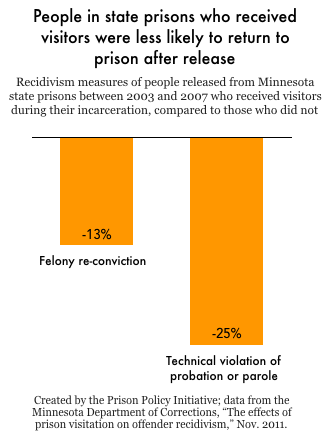One study for example found that 77 percent of criminal justice-involved youth reported substance use mainly marijuana in the past 6 months and nearly half of male and female juvenile detainees had a substance use disorder McClelland et al. When researchers plan to involve a prisoner population which answer best describes the type of federally supported research that may be conducted.

Over Half Of Americans Have Had A Family Member Incarcerated Infographic
People who violate.

. Prison research committees that may serve some type of proxy IRB role only infrequently include prisoners or prisoner representatives among their membership. Develop individualized treatment and service plans using information obtained from the risk and needs screening and assessment process. Determine the appropriate.
Incarcerated versus a reduction in the statewide population inclusive of the county jail and prison population. Plan for the treatment and services required to address the individuals needs both in custody and upon reentry. All of these factors point to a population of prisoners who may be more vulnerable and require stronger protections than those inspired by the commission in the 1970s.
10 Should a trial subject become a prisoner during participation that individual should be assigned the requisite precautions and safeguards. About 70 of offenders have been sentenced under the Justice Reinvestment Act. If the student is provided with a de- identified non-coded data set the use of the data does not constitute research with human subjects because there is no interaction with any individual and no identifiable private.
4 In its report on US. Of the 15 million adults currently in state and federal prisons the 55 demographic represents roughly twelve percent which represents a 300 percent spike in the elderly population since 1999. Department of Justices Office of Justice Programs reports a high rate of drug use among juvenile detainees.
For research involving prisoners the regulations at subpart C of 45 CFR part 46 define minimal risk as follows. An estimated 80 percent of individuals released from prison in the United States each year have a substance use disorder or chronic medical or psychiatric condition. 1-3 These estimates are three to five times higher than in the general population in which the prevalence of SMI ranges from 5 to 8 percent.
A vulnerable participant is any individual who lacks the ability to fully consent to participate in a study. 2 Local jails hold inmates sentenced to less than 1 year. Researchers arriving to interview incarcerated persons is a major event in the monotonous routine of prison life especially for an incarcerated person who is in isolation 23 hours a day.
Prevalence estimates of SMI among incarcerated adults range from 15 to 25 percent depending on the study and data source. Minimal risk is the probability and magnitude of physical or psychological harm that is normally encountered in the daily lives or in the routine medical dental or psychological examination of healthy persons 45 CFR 46303. Research indicates are related to criminal behavior.
Enterprises which is the prison industries component of the DOP has 29 factories employing 2600 offenders. Prisons and offenders with mental illness the. There are some groups who have been identified by the federal regulations as vulnerable populations.
4 Incarcerated individuals have four times the rate of active tuberculosis compared to the general population nine to 10 times the rate of hepatitis C and eight to nine times the rate of HIV. Social science research indicates each inmate possesses his or her own criminogenic factors such as criminal history substance abuse. The average age of 43 years old on January 1 2021 was up from 39 years old ten years ago in 2011.
Many student research projects involve secondary analysis of data that belongs to or was initially collected by their faculty advisor or another investigator. Instead of collecting numerical data points or intervene or introduce treatments just like in quantitative research qualitative research helps generate hypotheses as well as further investigate and understand quantitative data. Another notable trend is the continued aging of the population particularly among male inmates.
Used originally in the health care and social science fields evidence-based practice focuses on approaches demonstrated to be. Post Release Supervision violators make-up 167 of the prison population. The institutional population is 30978 males and 2247 females.
Qualitative research is a type of research that explores and provides deeper insights into real-world problems. Protection of Vulnerable Populations in Research In addition to vulnerable subject populations such as children prisoners and pregnant women covered in the subparts of the federal regulations for human subjects research there are special classes of subjects including students employees and cognitively impaired individuals who may be vulnerable in. The Bureau of Justice Statistics defines the incarcerated population as the number of inmates under the jurisdiction of state or federal prisons or held in local jails 1 State and federal prisons house inmates sentenced to more than 1 year of incarceration.
The first and most important step in reentry planning is obtaining information about an individual inmates risk of recidivating and programmatic needs that will inform development of an individualized reentry plan. Researchers have examined a variety of factors that could affect their subjects and the research. In the six years between 2001 and 2007.
One such factor is the Hawthorne effect in which social and. Pregnant women and fetuses minors prisoners persons with diminished mental capacity and those. Evidence-based practice EBP is the objective balanced and responsible use of current research and the best available data to guide policy and practice decisions such that outcomes for consumers are improved.
Mostly research conducted on prisoners pertains to health and social issues with potential direct benefits confined to their environmental conditions.

Research Roundup The Positive Impacts Of Family Contact For Incarcerated People And Their Families Prison Policy Initiative

We Aren T The World Western Educated Industrialized Rich And Democratic Or Weird Social Science Educational Infographic Psychology

0 Comments